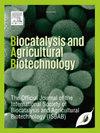用于伤口愈合、抗氧化、抗菌和抗癌干预的生物合成 AGS@AgNPs
IF 3.4
Q2 BIOTECHNOLOGY & APPLIED MICROBIOLOGY
引用次数: 0
摘要
伤口愈合缓慢和伤口感染是烧伤患者面临的重大挑战。利用植物提取物进行纳米粒子(NPs)的生物合成提供了一种快速、简便、安全的生物相容性 NPs 生产方法。在本研究中,Anethum graveolens seed(AGS)提取物作为掩蔽剂和还原剂用于合成银纳米粒子(AGS@AgNPs)。首先,优化了影响 AGS@AgNPs 合成的参数,包括硝酸银浓度、反应时间、温度和 pH 值。随后,对 AGS@AgNPs 的结构和生物特性进行了评估。在约 420 纳米波长处观察到 AGS@AgNPs 的表面等离子体共振(SPR),同时悬浮液的颜色变为深棕色,这证实了 AGS@AgNPs 的合成。通过 X 射线衍射 (XRD)、傅立叶变换红外光谱 (FT-IR)、动态光散射 (DLS)、ZETA 电位和透射电子显微镜 (TEM) 分析,证实了使用 Anethum graveolens 提取物生产出了纯净、均质、球形和稳定的银 NPs,其尺寸范围为 20 至 40 nm。抗菌试验显示,该产品对革兰氏阳性和革兰氏阴性细菌菌株均有显著的抗菌活性。抗氧化评估表明,浓度为 250 μg/ml 的 AGS@AgNPs 对 DPPH 自由基的抑制率为 92%;在 FRAP 试验中,A. graveolens 种子提取物和 AGS@AgNPs 将 Fe3+ 离子还原为 Fe2+ 的比率分别为 48.7% 和 73.1%。对肺癌细胞株(A-549)抗癌特性的研究表明,其 IC50 值为 242 μg/ml。流式细胞仪检测和乳酸脱氢酶(LDH)检测结果表明,癌细胞已经死亡。此外,伤口愈合试验表明,在使用 AGS@AgNPs 治疗后的第 3、7 和 14 天,大鼠烧伤伤口的闭合速度明显加快。总之,这些研究结果突显了 AGS@AgNPs 的良好生物活性,表明其在纳米医学应用中具有潜在的实用性。本文章由计算机程序翻译,如有差异,请以英文原文为准。
Bio-synthesized AGS@AgNPs for wound healing, antioxidant support, antibacterial defense, and anticancer intervention
Slow wound healing and wound infections are significant challenges for burn patients. Biosynthesis of nanoparticles (NPs) using plant extracts offers a rapid, facile, and safe method for producing biocompatible NPs. In this study, Anethum graveolens seed (AGS) extract served as a masking and reducing agent for the synthesis of silver nanoparticles (AGS@AgNPs). Initially, the parameters influencing AGS@AgNPs synthesis, including silver nitrate concentration, reaction time, temperature, and pH, were optimized. Subsequently, AGS@AgNPs structural and biological characteristics were evaluated. Observation of the surface plasmon resonance (SPR) of the AGS@AgNPs at approximately 420 nm, accompanied by a color change of the suspension to dark brown, confirmed AGS@AgNPs synthesis. Analysis via X-ray diffraction (XRD), Fourier-transform infrared spectroscopy (FT-IR), dynamic light scattering (DLS), zeta potential, and transmission electron microscopy (TEM) confirmed the production of pure, homogeneous, spherical, and stable silver NPs with sizes ranging from 20 to 40 nm using Anethum graveolens extract. Antibacterial assays revealed significant activity against both Gram-positive and Gram-negative bacterial strains. Antioxidant assessments demonstrated that AGS@AgNPs at a concentration of 250 μg/ml exhibited 92% inhibition of DPPH free radicals and in FRAP test, A. graveolens seed extract and AGS@AgNPs reduced Fe3+ ions to Fe2+ by 48.7% and 73.1%, respectively. Investigation of anticancer properties against the lung cancer cell line (A-549) revealed an IC50 value of 242 μg/ml. The results of the flow cytometry test and lactate dehydrogenase (LDH) assay demonstrated the death of cancer cells. Moreover, wound healing assays demonstrated a significant acceleration in burn wound closure rates in rats on days 3, 7, and 14 following treatments with AGS@AgNPs. Overall, these findings highlight the favorable biological activities of AGS@AgNPs, suggesting their potential utility in nanomedicine applications.
求助全文
通过发布文献求助,成功后即可免费获取论文全文。
去求助
来源期刊

Biocatalysis and agricultural biotechnology
Agricultural and Biological Sciences-Agronomy and Crop Science
CiteScore
7.70
自引率
2.50%
发文量
308
审稿时长
48 days
期刊介绍:
Biocatalysis and Agricultural Biotechnology is the official journal of the International Society of Biocatalysis and Agricultural Biotechnology (ISBAB). The journal publishes high quality articles especially in the science and technology of biocatalysis, bioprocesses, agricultural biotechnology, biomedical biotechnology, and, if appropriate, from other related areas of biotechnology. The journal will publish peer-reviewed basic and applied research papers, authoritative reviews, and feature articles. The scope of the journal encompasses the research, industrial, and commercial aspects of biotechnology, including the areas of: biocatalysis; bioprocesses; food and agriculture; genetic engineering; molecular biology; healthcare and pharmaceuticals; biofuels; genomics; nanotechnology; environment and biodiversity; and bioremediation.
 求助内容:
求助内容: 应助结果提醒方式:
应助结果提醒方式:


